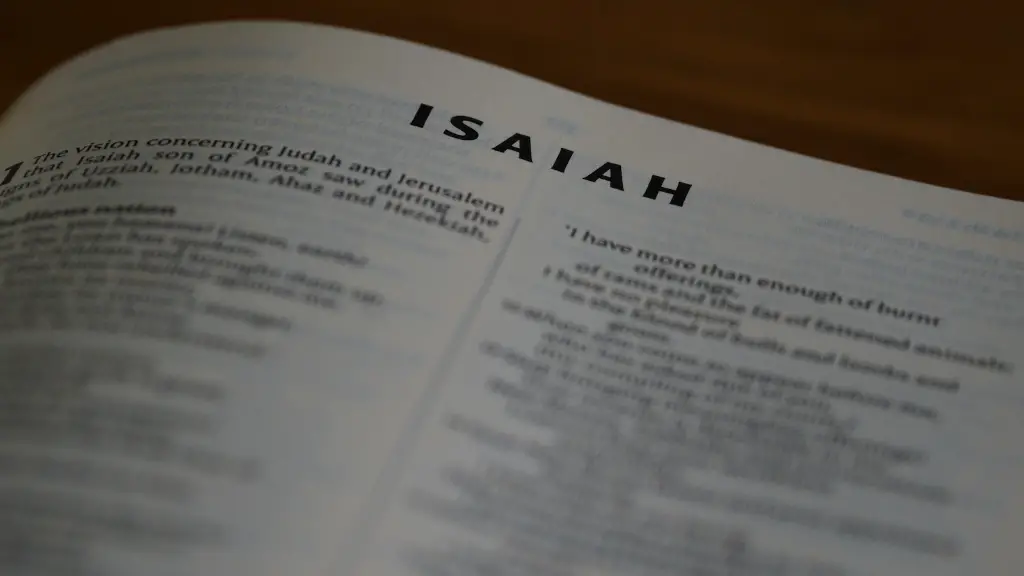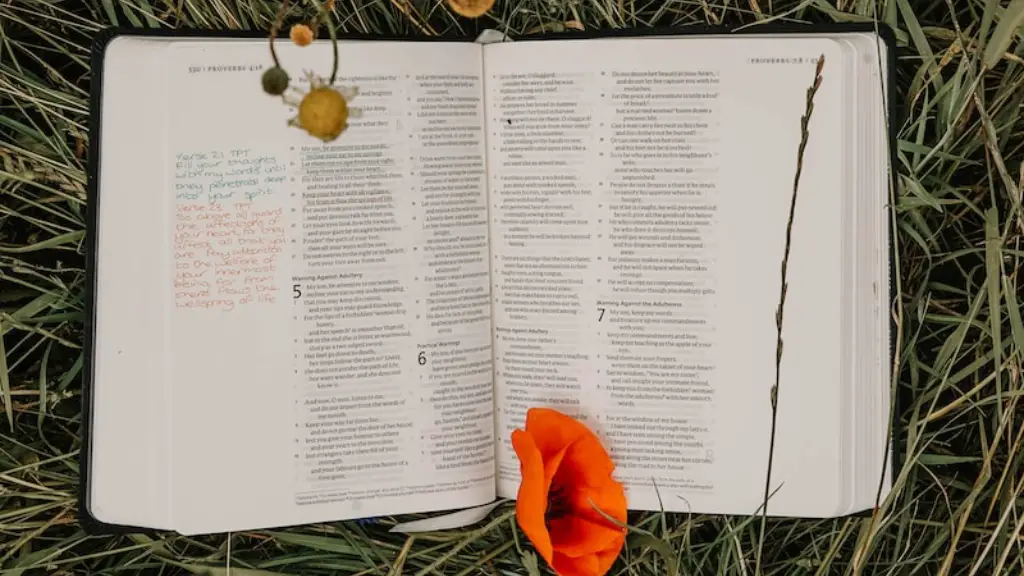Background Information
Reading the Bible can be a daunting task due to its sheer size and complexity. Containing over 700 stories and chronicles, it’s the world’s largest, most popular book and a vast source of inspiration. Whether you’re an experienced Bible reader or beginning your journey, understanding where to start is vital in order to gain an appreciation of the Bible’s over-arching storyline. Deciding where to start in the Bible can be a daunting task.
The Old Testament
The Old Testament contains a total of 39 books and is divided into four main categories; the Law, the Prophets, the Writings and the History. Starting with Genesis and ending with Malachi, the Bible reaches from the creation account in Genesis to the proclamation of God’s final judgement in Malachi. It’s important to note that the Jewish faith considers its scriptures as one, unified document.
The Law, also known as the Pentateuch, contains the first five books of the Bible – Genesis, Exodus, Leviticus, Numbers and Deuteronomy. Written by Moses the Law sets out a foundational foundation for understanding God’s will and relationship with his chosen people; the Israelites.
The Law is followed by books of the Prophets. This section has 15 books – five of them major and the rest minor prophets. These books are a record of God’s conversation with his people and through his prophets, contains both warnings to those who fail to keep God’s covenant and encouragement of hope for all who will.
After the Prophets, the Writings section comes. These books are a collection of literature, including poetic pieces such as the God-inspired hymns of the Psalms and prose such as the story of Job. They provide an emotional backdrop to scripture, demonstrating the different facets of relationship with God.
Finally, the History section goes through the accounts of Israel’s history, overlapping with the twelve minor prophet books. These books bring to life the backdrop of slavery, conquest, kings and exiles, recording the rapid rise and challenging fall of the Israelites.
The New Testament
The New Testament takes off where the Old Testament comes to an end. It consists of 27 books, and covers the life, teachings, death and resurrection of Jesus as found in the Gospels, as well as his teachings as shared by the Apostles in the early church. It begins in the Gospel of Matthew and concludes in Revelation.
The first four books of the New Testament, Matthew, Mark, Luke and John, tell the Story of Jesus’ life, death, resurrection and teachings. Through Matthew, Mark, Luke and John, readers can be witnesses to the events throughout Christ’s life and gain a better understanding of the Savior.
After the four Gospels, the New Testament then moves on to an account of the early church written by Paul and other Apostles and prophets of the time. This collection of books contains letters, sermons, and letters between the Apostles. Throughout these books, the Apostles are trying to encourage the church as they spread and face various issues and challenges.
The New Testament then ends with the book of Revelation, written by John. In this book, John is writing during a time of great persecution and foretells of Jesus’ ultimate victory and of the final judgement day.
Understanding the Bible in Context
To gain an appreciation of the overall message of the Bible, it’s important to try and understand its context. Looking at who wrote it, to whom it was written and when gives a reader an understanding of the book’s intention.
The books of the Bible were written over a period of 1600 years, and much of the Old Testament was recorded before the birth of Jesus. Every book has its own purpose, reflecting the spiritual and cultural customs of its time. To fully understand the Bible’s intent, it’s important to consider the cultural and religious context within which it was written.
Using Bible Study Tools
Bible study tools can be used to help focus Bible reading. These include Bible commentaries, Bible dictionaries and concordances, which help readers to explore key characters, places, and topics in detail. Bible reading plans can also be used to assist structure and direction.
Bible study tools are particularly useful for deeper study, as they can help readers to identify core themes and discover the impact of the Bible on society and Christianity today. Bible studies can also be useful for learning how to apply Biblical teaching in a variety of different situations.
Getting the Most Out of Bible Reading
In order to get the most out of Bible reading, it’s important to set goals and actionable activities for each session. It’s helpful to create a structure to the reading and make sure that the aim is both to inform and be inspired.
Take notes as you go. This will help in recollecting and selecting meaningful passages for further reflection. Regular Bible reading aides memorisation, reflection and understanding. Seek out devotionals, podcasts, and speakers to provide an additional element to Bible reading.
Applying Biblical Truths
Understanding the Bible comes from applying its truths to everyday life. Read passages and ask, “How do they apply today?” and “What do they tell us about God and his character?” Experiment and explore different applications of passages. Keep a journal to reflect on how particular scriptures have impacted you and encouraged reflection and change in your lifestyle.
Bible Trips and Tours
Bible trips and tours are a great way to experience the Bible in a more intimate way. Bible trips are a great starting point for getting to know the Bible in its original context. Bible trips take place in Israel, and start with a visit to Jerusalem, followed by exploring Galilee, the Negev and the Judean Desert. On the trip, you can visit all the major Bible sites and locations, such as the Sea of Galilee, the Garden of Gethsemane and the Mount of Olives.
Ways to Engage with the Bible
Creating a Bible reading plan and structure is essential to getting the most out of Bible reading, but equally important is developing a habit of Bible engagement, both in your reading and daily life. To do this, take part in group Bible studies, such as those offered at churches, or look for other opportunities to engage with the scriptures, such as Bible classes or workshops.
Interacting with the Bible through drama, art and literature can also be an effective way of engaging with the scriptures in a fresh, exciting and transformative way. Through these activities, you can gain an enhanced appreciation for the Bible and gain insights into how to apply it to your life.
Prayerful Interaction with the Bible
Interaction with the Bible should be prayerful. Recognise that the Bible is God’s Word and ask him to lead you in your reading and understanding. Ask God enlighten your understanding of the Bible and to help you to apply it to your life. Prayerful Bible reading is essential to strengthening one’s faith and walk with Christ.
Bible Apps
Technology has become an essential tool in our lives, and many Bible Apps are now available to assist us in our Bible reading. These Bible Apps provide easy access to scripture reading and offer helpful tools to stay organized, such as Bible reading plans, devotional studies and prayers. Many Bible Apps offer a number of different translations and are regularly updated with new content to help bring fresh insights into your Bible study.
Translating the Bible for Today’s Audience
In order to ensure the relevance of the Bible for today’s audience, organisations such as The Bible Society are dedicated to researching and translating the Bible with the goal of bringing the scriptures to life for everyone. The Bible Society has partnered with experts to provide easy to access translations and resources to make the scriptures easy to understand and apply in our everyday lives.
Conclusion
Understanding where to start in the Bible can be a daunting task, but with the right strategies, understanding and application of the Bible is possible. Through prayerful interaction and engaging with the scriptures in a variety of ways, readers can understand the Bible’s over-arching narrative, message and intent. Bible trips, Bible study tools and technology can all be used to help readers deepen their understanding and expand their appreciation of the scriptures.



